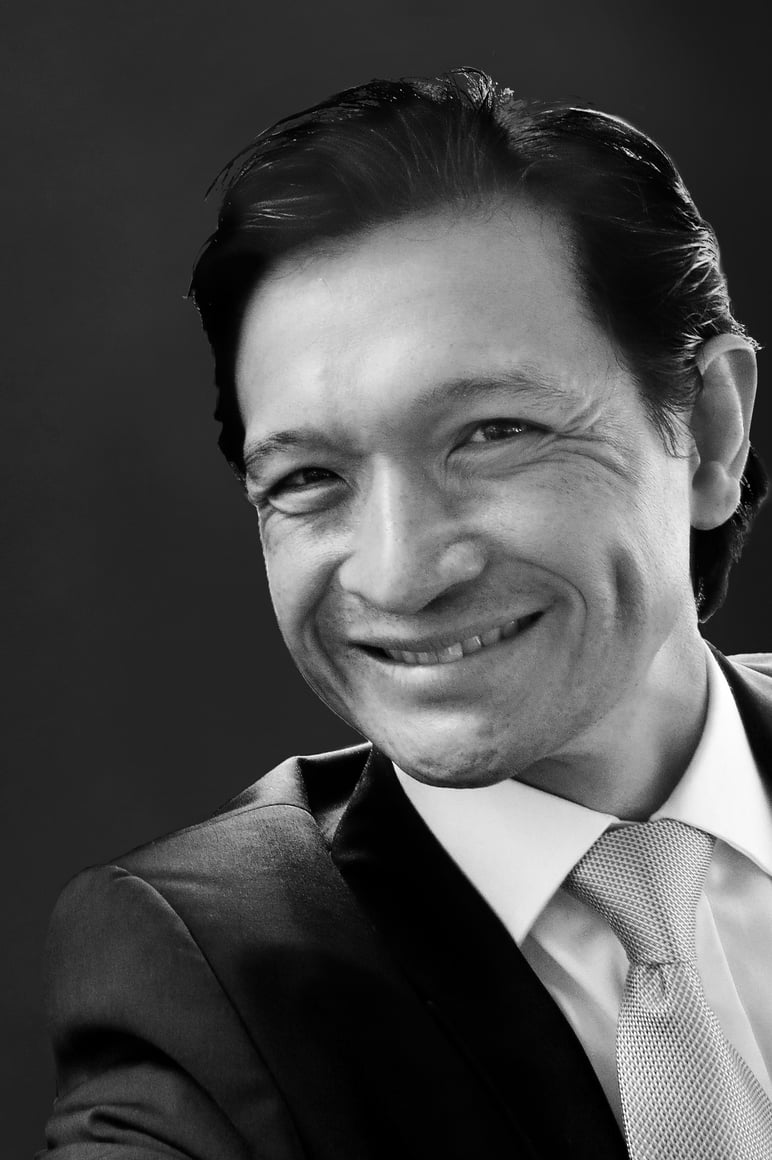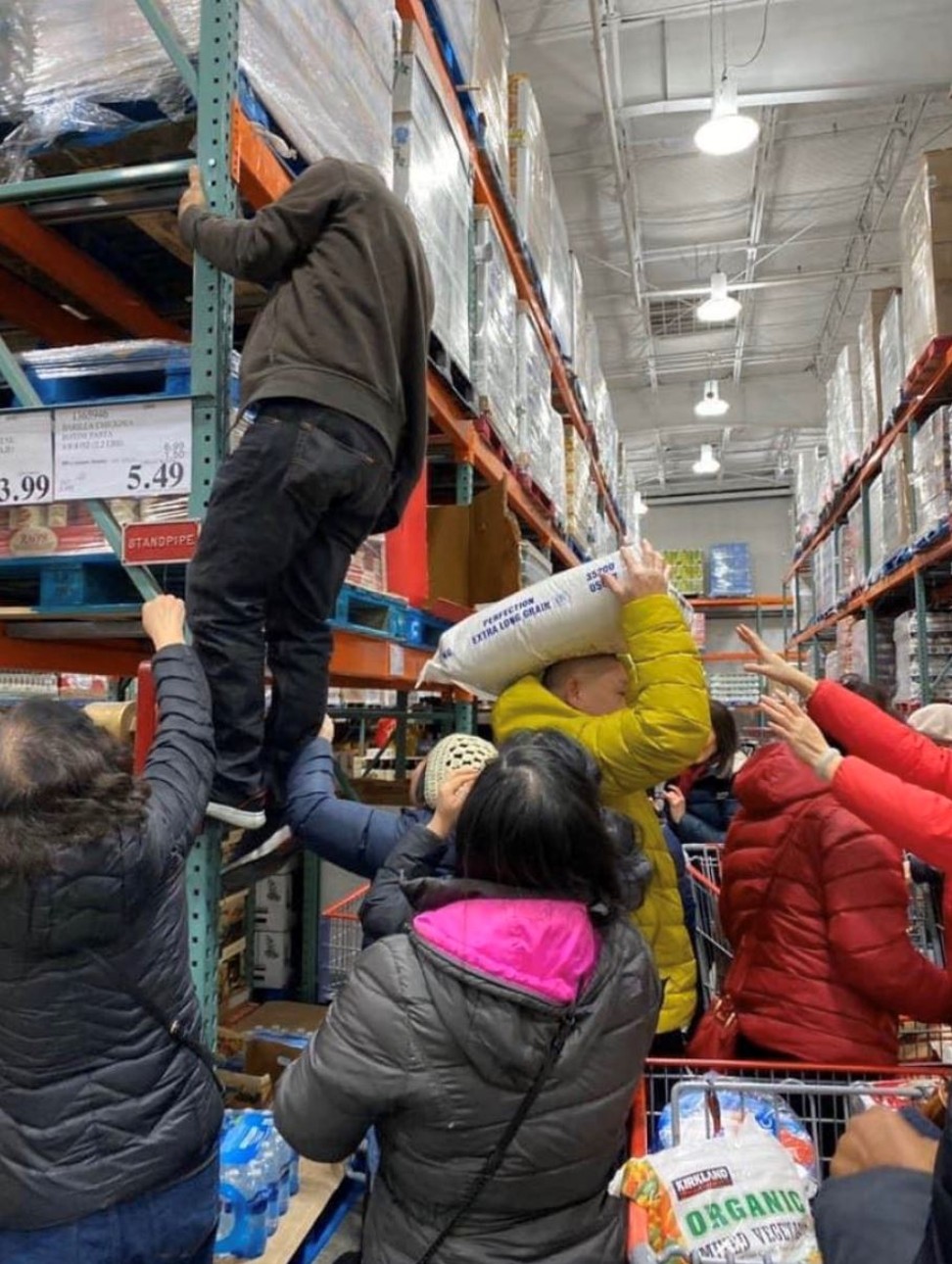
Panic at the Costco: coronavirus, a bogus photo and the contagion of fear behind Vancouver’s supermarket stampede
- The Hongcouver Blog: A much-shared photo said to show panic buying in the Vancouver satellite of Richmond wasn’t even taken in Canada
- But it fuelled real panic buying in the region, illustrating how fear can become a ‘self-fulfilling prophecy’ during times of pandemic
I first saw the rice raiders of Richmond, outside Vancouver, on Saturday evening in a message from an older relative, who got the photo from a friend, who received it in a group message to their Chinese singing troupe, that received it from who knows where.
It shows one man literally climbing the distinctive scaffolding racks of a Costco store to pass down sacks of rice to shoppers below, their arms stretched out in supplication. An Asian man carries away a sack on his head. A woman in a down jacket with a hot-pink lined hood cranes her head upwards in the foreground.
Only in Richmond, eh, that most Chinese of Canadian cities, where concerns about coronavirus are being felt so acutely.
At least, the frantic scene was supposed to be in Richmond, according to messages shared and reshared on multiple platforms, privately and publicly, in Chinese and English alike.

A single Facebook post in a group popular with the young Asian diaspora gathered more than 11,000 likes, with commenters repeatedly asserting the scene to be Richmond.
Yet, in other corners of social media, there was the same photo, and a matching video.
It was actually in Flushing, New York, some said.
That has turned up in every pandemic going back to the bubonic plague in the Middle Ages
No wait, it was taken by a buddy in San Francisco.
Ontario.
Seattle.
One thing can be said with certainty: that Costco definitely wasn’t in Richmond (more on that later).
“The woman with the pink lined hood has made quite the journey today,” observed one droll Twitter user, who collaged the contradictory tweets.
Coronavirus ‘misinformation’ in Canada? China’s embassy shares the blame
The photo, also shared on Chinese-language news websites (and wrongly described as being taken in Richmond), was one cog in the mechanism that has driven frantic buying of rice, toilet paper and other household goods in the Vancouver region for almost a week, and is now spreading to other parts of Canada.
The phenomenon, mirroring similar events in Hong Kong, Australia, Italy and the US, is very real.
But it is also an example of the self-fulfilling prophecy of panic buying, a feedback loop of information and misinformation that can drown out common sense.
Panic trolls, from the bubonic plague to Covid-19
University of British Columbia clinical psychologist Dr Steven Taylor is the author of The Psychology of Pandemics. In a timely coincidence, his book was published just a few weeks ahead of the apparent emergence of Covid-19 in Wuhan late last year.
He defined panic buying as being fuelled by “anxiety, urgency and fears of scarcity … that could lead people to go to great length to buy and can lead to overbuying.”
He said mischief makers who spread misleading images or rumours of panic buying were ubiquitous during pandemics (the WHO has yet to officially label the Covid-19 outbreak a pandemic, but it fits most descriptions.)
“That has turned up in every pandemic going back to the bubonic plague in the Middle Ages,” said Taylor. “These days we call them trolls.”
Their goal, he said, “is to falsely perpetuate fear”.

“The psychology is for all kinds of reasons. For some it’s just a prank, for others it might give them a sense of power, in the ability to manipulate other people’s emotions. It’s an antisocial thing, this desire to feel powerful.”
The scene of the “Richmond” rice raiders was a classic example of the type of bogus rumour that triggered an emotional response from potential panic buyers, said Taylor.
“Some people will be able to step back and say, ‘hang on, is that real?’ But others will buy into the truth of the image, and it can be very powerful. Those kind of images stick in your mind. They influence your judgment, about how scarce things are. Images of fully stocked shelves don’t go viral.”
That’s like the person in a burning theatre saying, I’m going to get ahead of the stampede by running to the exit first
On numerous occasions, the misleading photo was shared with other pictures that accurately showed scenes of empty shelves in Richmond’s Costco (including the group of pictures from WeChat shared by my relative).
This combination of a startling, inauthentic image, with authentic but less dramatic images was common, said Taylor. “If you want to make a bogus image look credible, you blend it with credible images,” he said.
Those Asian face mask wearers? They aren’t crazy or stupid, Vancouver
The photo was fuel on the fire. But the rush to Canada’s supermarkets was likely sparked last week by Canada’s health minister, Patty Hajdu.
In an apparently off-the-cuff comment on February 26, in response to a hallway press scrum question about stockpiling food and other necessities, Hajdu said, “It’s always good when there’s a global crisis such as coronavirus to be prepared because things can change quickly.”
She said this was “a wise recommendation for all kinds of crises … we want Canadians to be prepared to take action if we see an outbreak”.
The advice was hedged, but the headlines carried an unambiguous message: start stockpiling.
And the next day, Canadians were doing just that, in Richmond and elsewhere. Many flocked to Costco, the members-only warehouse chain that is the world’s most famous buy-in-bulk retailer.
At times – including when the South China Morning Post visited the Richmond store late on Friday afternoon – the shelves were amply stocked. But on numerous other occasions and at various outlets depicted on social media, the racks were bare, queues snaked through car parks and trolleys were stacked high with rice, toilet paper and other goods.
(Costco Canada’s head office did not respond to a request for comment lodged with the Richmond store’s warehouse manager.)
Taylor said it was important to distinguish panic buying from what he called “realistic and logically planned buying” in response to advice from authorities, such as Hajdu.

But he said Hajdu had had to walk a fine line with her comments.
“On the face of it, the phrasing of her statement was good. However, you need to consider your audience. In an ideal world it would be sensible for all of us to have a two-week supply of groceries and medicine and toiletries … but most of us don’t do that, and suddenly you get a news announcement ‘go out and get two weeks of groceries’ and that’s going to alarm people.
“It can be a well-intended, well-phrased answer to a question that inadvertently leads to panic buying.”
Indeed, by this Wednesday, Hajdu was reportedly trying to walk back the stockpiling advice, saying it had been mischaracterised.
But the feedback loop is already well underway, as photos of empty shelves continue to flood social media, heightening perceptions of scarcity and uncertainty, and in turn fuelling further panic buying.
Associated phenomena such as opportunistic price gouging on resale sites has also emerged.
Vancouver donates thousands of masks to Wuhan, but virus profiteers cash in
One of the challenges in deterring panic buying is that no one likes to think of themselves as panicking.
Taylor pointed to how some people might decry panic buying – but nevertheless excuse themselves on the grounds that they were simply stocking up to get ahead of true panickers.
“That’s like the person in a burning theatre saying, I’m going to get ahead of the stampede by running to the exit first,” he said. “They’re not getting ahead of it. They’re just an early adopter. They might become the first wave of panic buying. That’s panic buying from the start.”

It’s not just fear of shortages that fuels panic buying – it’s fear of panic buying itself.
It may be a hall of mirrors but the consequences are no illusion. “The perception of shortage can create real shortages,” said Taylor. “If the general public is buying up all the face masks, which are unnecessary for people in the community, that can lead to shortages for health care workers.”
Panic-buying tendencies are not restricted to any one group, but different communities might respond to perceptions of shortages differently, said Taylor.
“If, for instance, more ethnically Chinese people are buying more stuff, that doesn’t necessarily mean they’re doing more panic buying,” he said. “It might just be they have more people they think they have to buy for.”
And in some groups, globalised social media could accelerate panic buying, when shared images from friends and family overseas were helping convince people, mistakenly, “about what is happening right here, now”.
‘People need to lead by example’
Which brings us back to the where and the when of the original rice raid photo.
It was not taken in Richmond’s Costco, nor elsewhere in Canada. Goods are labelled in pounds and ounces, not metric weights, with prices corresponding to recent US discounts. And the rice is shown in a mid-store rack, while Richmond’s Costco usually stocks it against a wall.
A report by ABC 7 News on Saturday evening said the scene occurred in a Costco in Mountain View, California, that day. But the image was uncredited, and the photo had been shared on Twitter as early as 4.49pm Pacific time on Friday. That user claimed the picture was taken in a Toronto Costco, but did not immediately respond to a message about who took it.
Exactly when and where the scene took place remains unclear. But it continues to be shared widely and falsely depicted as Richmond.

Taylor said anyone alarmed by scenes of panic buying should pause to consider the rest of the community in deciding how to respond.
“Fear is contagious. If they run around like a headless chicken, everyone else will too,” he said. “Ask yourself: how much do I really need? How much does my neighbour need?
“It’s identical to crowd control in an arena … if there’s an incident, the worst thing you can do is start stampeding for the exit. People need to think about leading by example.”
The Hongcouver blog is devoted to the hybrid culture of its namesake cities: Hong Kong and Vancouver. All story ideas and comments are welcome. Connect with me by email [email protected] or on Twitter, @ianjamesyoung70.
Purchase the China AI Report 2020 brought to you by SCMP Research and enjoy a 20% discount (original price US$400). This 60-page all new intelligence report gives you first-hand insights and analysis into the latest industry developments and intelligence about China AI. Get exclusive access to our webinars for continuous learning, and interact with China AI executives in live Q&A. Offer valid until 31 March 2020.

